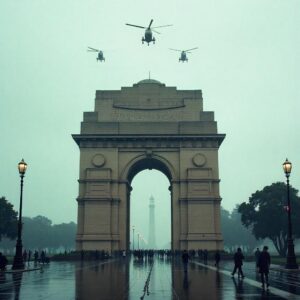Seeding the Skies: Can Artificial Rain Wash Away Delhi Smog?
Delhi’s Government, in collaboration with IIT Kanpur, is all set to carry out five cloud-seeding flights, which are targeting polluted air pockets on the outskirts of the city from the 4th to 11th of July 2025. This will be the first large-scale artificial rain trial in Delhi.
Use of Seeding agents, which are typically silver iodide or salt powders used to nucleate raindrops. The aircraft fleet is a light aircraft equipped with precision flares. Operational conditions require a minimum ambient cloud moisture of around 40-50% is essential for success. Each flight will focus on 100km hot zones with five sorties planned. The total budget is of ₹3.2 crores, which makes it ₹55 lakhs per trial.

Goals And Limitations :
Expected benefits are that temporary PM reduction through washout effects, as rain lifts particulate matter out of the atmosphere. There will be public health relief for a while and coverage of 100km districts.
Some challenges which we can expect are that, without enough cloud moisture seeding may fail or cause rain somewhere else. Pollution may return within 48-72 hours without source-level control. Authorities like CPCB, CAQM, and IMD caution against cloud seeding in dry periods, citing uncertain outcomes.
Environment Context :
Misting systems on busy roads and anti-smog guns. Regulatory steps under the environmental action plan include sprinklers, smog guns, ANPR cameras, and dust control at construction sites. There are criticisms that these are band-aid solutions, which are long-term fixes like emission regulation, public transport investment, and regional cooperation remain essential.
Recommendations:
Pre-trial ( Next 2-4 weeks) – Aviation as service companies should be ready fleet, crews, and safety certifications. meteorology providers should monitor cloud conditions in real time. Every chemical supplier should stock seeding agents as per DGCA norms. Legal consultancies should progress NOC applications swiftly
During trial ( 4th – 11th July) – Analytics and monitoring services should be active for real-time AQI readings pre-, during, and post-seeding. Media partners should ensure for transparent messaging around the impact. Air sampling labs residue assessments.
Post trial – Data analytics teams should study AQI dips, spatial effectiveness, and precipitation volumes. Pollution control firms to explore how cloud seeding fits into long-term strategies. Policy advisor should recommend scaling or pivoting toward source-control measures.
In hope for success we need to be with our government and should follow what they will ask us to do. Hope this step would benefit all of us and we can live our lives hassle free. For more such updates and latest news visit Industrial Front.
